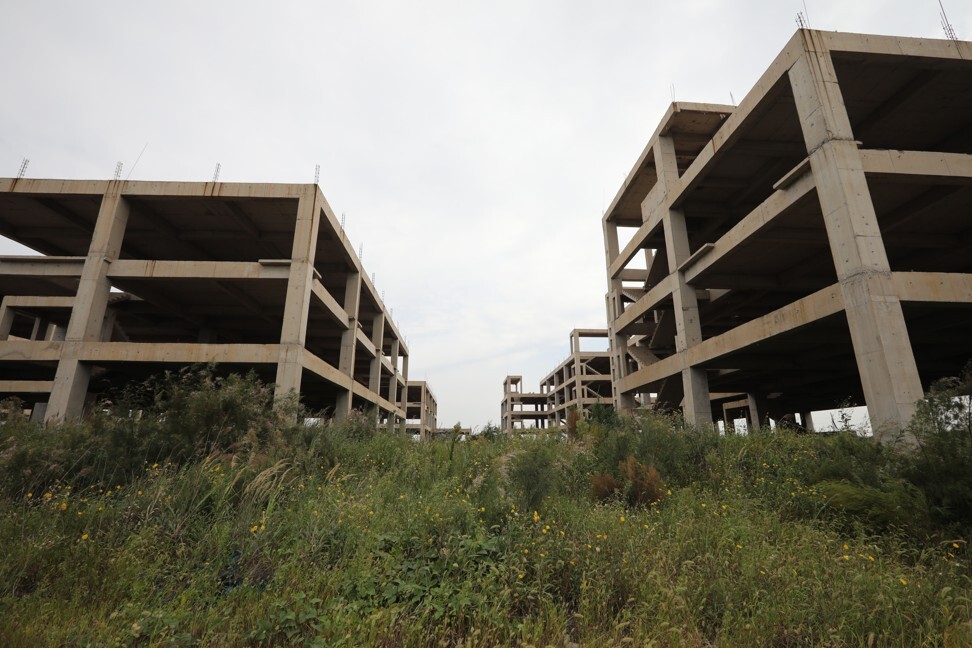Hong Kong News

Chinese ghost town rumbling back to life as free-trade zone
Along the coast and a stone’s throw from the headquarters of Caofeidian’s Economic and Technological Development Zone, in Hebei’s Tangshan city, small groups of people hurriedly collect cockles before the tide returns.
Around the government building, there are a series of Caofeidian Rural Commercial Bank advertisements hanging on street lights powered by solar and wind energy, enticing entrepreneurs to take out loans: “Achieve your dreams, start your business”, and “Loans for big firms of the future, serving small and medium-sized firms”.
Besides the huge government headquarters, the surrounding area features few people and vehicles, making Caofeidian’s economic zone look more like a fishing town than a business and tech district. Even though fishing is officially discouraged, the cockle collectors still took the risk.
“New businesses? I don’t know. I can’t see many businesses here. I only come here to catch some seafood,” said a cockle picker from Tangshan, her bicycle basket filled with her haul for the day. “It’s usually quiet here. I can even catch some crabs sometimes on the other side. I eat them, they are not for sale.”

Like many cities like in China, Caofeidian became a ghost town in 2014 after debt ballooned in the area, in this case following a failed attempt to diversify away from heavy industries. In 2016, when the South China Morning Post last visited Caofeidian, on the edge of China’s top steelmaking city of Tangshan, it was filled with unfinished buildings, as well as mostly locked up and abandoned hotels and commercial blocks.
A look at rating agencies’ reports on the Tangshan Caofeidian Development Investment Company, the go-to local government financing vehicle for infrastructure borrowing for the district, showed that Caofeidian had relied on land deals to make money. Key industries – steel, chemicals, energy and equipment production – generated little income growth, and attempts to upgrade the economy yielded little return.
But signs are pointing to the ghost town gradually coming back to life. Some of the construction that had been abandoned years ago is returning.
From 2017 to 2018, fixed asset investment in Caofeidian plunged from 89.18 billion yuan (US$13.04 billion) to 60.05 billion yuan, according to Tangshan’s official figures. But last year, the total investment started to go back up, with a year-on-year increase of 11.3 per cent year to 64.93 billion yuan.
The once-deserted city’s second chance came when it was designated a free-trade zone last year.
China expanded its free-trade zones to six provinces in 2019, including underdeveloped regions such as Hebei, making them more attractive to high-quality manufacturing in a bid to support the local economies and help weather the impact from the ongoing trade war with the United States.
The pilot free-trade zone in Caofeidian is prioritising the development of international commodities trade and pulling in more foreign investment, the local government said in April.
Renewed support from Beijing, and a switch of focus to commodities trading, look to help Caofeidian grow its economy and investment. But the earnings of such business are likely to be slim, according to a research report compiled in July by CCXI, a subsidiary of US-based rating agency Moody’s that focuses on China’s debt market.
“The gross profit margin is low and profitability is weak,” the report said, referring to the Tangshan Caofeidian Development Investment Company.
Borrowings for the financing vehicle steadily dropped over the last four years. Last year, they totalled 24.75 billion yuan, compared with 43.75 billion yuan at the height of its spending in 2015.

China’s state assets manager, the State-owned Assets Supervision and Administration Commission (SASAC), stepped in last year, offering funds to ease Caofeidian’s debt burden, mostly via short-term borrowings. According to CCXI, outstanding debt was 124.35 times larger than Caofeidian’s operating cash flow in 2017.
In 2019, the Tangshan branch of the SASAC injected 1.96 billion yuan (US$286.6 million) into the financing vehicle, which also received equity transfers and debt-to-equity swap investments totalling 7.37 billion yuan, along with a subsidy of 770 million yuan from the local government, according to the CCXI report.
Now there are workers driving trucks at the previously deserted construction site of a property project on Zhongshan Road. Construction on the project, with office blocks and a luxurious members-only club, was originally supposed to begin in 2013.
But now several new real estate projects are popping up. Just 4km (2.5 miles) away from Zhongshan Road, construction was also taking place on a development launched last year – CBD Linxiaocheng, a compound that includes offices, hotels and flats.
Colourful banners boasting Caofeidian’s credentials – “China’s number one port,” and “GDP per capita, industry clusters, and regional construction are among the top” – are splashed across the development site.
While it may be déjà vu for property developers jumping on the bandwagon again as Caofeidian seeks to rejuvenate its economy, the outlook for an industry transformation by itself remains challenging in state-dominated Hebei.
The skeletal steel frames of some buildings remain untouched along Zhongshan Road, serving as a reminder of the failed construction spree that resulted in Caofeidian’s ghost-town status.
“Hebei has been trying for economic transition. The services sector has been taking up a higher share of the economy from its industrial counterpart, underpinning the return of the province’s growth to levels on par with China’s since 2015,” said Standard & Poor’s in a report on Hebei’s overall debt in August.
“The local economy’s revenue-generation capacity is weak, leading to the government’s reliance on central government transfers on par with the local and regional government sector,” S&P said.











